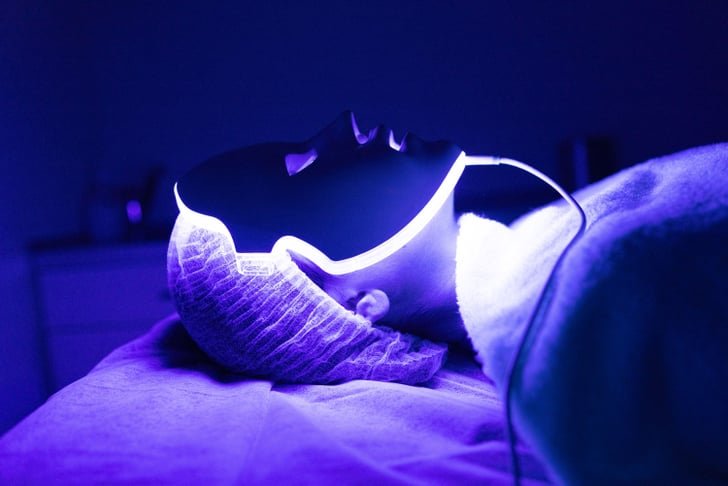Blue Light Therapy for Sensitive Skin
Photo from Popsugar
LED light treatments have been popular in recent years and for a good reason. For those suffering from acne, it can be a miracle. It is a gentle, low-impact light therapy that can be used with nearly any treatment.
Blue light therapy can be done professionally as part of medical treatment, and it is even for daily use at home. It is minimally invasive and will not damage your skin.
It works to kill bacteria, reduce inflammation and accelerate open wound healing. Typically, those with sensitive skin or an open breakout have to be mindful of all products and services, but blue light is safe for all skin types. It makes an excellent addition to a healing-focused regimen (2).
How does light therapy work?
LED light is a type of phototherapy that emits visible light. Each wavelength penetrates the skin at a different depth and produces a range of benefits. Purple and Blue hues tend to penetrate the epidermis, the first layer of the skin. Orange and Red hues reach the hypodermis and can affect blood flow and metabolism of the skin.
Red light is anti-aging and helps build collagen.
Yellow / Orange Light helps minimize redness and has astringent properties
Blue Light kills bacteria and reduces inflammation
Each tone is used for both targeted sessions that address a single concern or in tandem for a multi-benefit effect.
There is a bit of confusion around the benefits of blue light therapy. Some effects of blue light are harmful, such as the kind emitted by digital devices. When a large part of our lives is digital, we have to be concerned with skin damage and the effects on our vision and mental state. Products that prevent this type of damage have emerged on the market. Our sustainable, vegan retinol alternative with blue light blocking properties is a great example.
But, blue light therapy is still effective when used as part of a treatment plan. It has tons of beneficial qualities, so we are here to break it all down.
Is Blue light beneficial or harmful?
You may be thinking - isn’t light known to damage skin? Yes and no. Blue light kills acne bacteria when used directly and in low doses. Ongoing exposure to blue light without protection can be damaging. So basically, it’s all in quantity and intention (1).
Yes, we always recommend wearing blue-light-blocking skincare or sunscreen to protect against damage. Daily exposure through our devices and sunlight should generally be limited. UV rays from tanning outdoors or in an artificial tanning bed damage the skin and cause skin cancer. Daily exposure risk is much different than intentional LED blue light.
What does blue light treat?
Blue light is known for killing acne bacteria, and it’s effective for nearly all skin types (2). Clinical studies have shown that blue light therapy is effective in healing microcysts, pustules, and small nodules (1). It causes a reaction that produces oxygen which naturally kills bacteria. Blue light also helps heal acne by modulating the skin’s inflammation response (1).
Blue LED can be an excellent tool for sensitive skin in decreasing inflammation and healing acne gently without harsh long-term treatments. The LED light is an excellent addition to a treatment plan for an effective result for more advanced acne.
What are the benefits of blue LED light therapy?
It kills the bacteria P. acnes
Regulates oil production
Decreases inflammation
Increases circulation helping fine lines
Brightens your complexion
Blue light: Friend or foe?. 2020. Bonnans M., Fouque L, et. al. https://www.sciencedirect.com/science/article/pii/S1011134420304760
Low-level laser (light) therapy (LLLT) in skin: stimulating, healing, restoring. Avci, P. 2014. www.ncbi.nlm.nih.gov/pmc/articles/PMC4126803/
